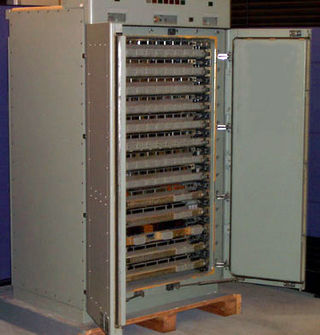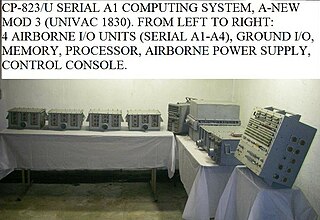Related Research Articles

UNIVAC was a line of electronic digital stored-program computers starting with the products of the Eckert–Mauchly Computer Corporation. Later the name was applied to a division of the Remington Rand company and successor organizations.
The AN/USQ-17 or Naval Tactical Data System (NTDS) computer referred to in Sperry Rand documents as the Univac M-460, was Seymour Cray's last design for UNIVAC. UNIVAC later released a commercial version, the UNIVAC 490. That system was later upgraded to a multiprocessor configuration as the 494.

The AN/USQ-20, or CP-642 or Naval Tactical Data System (NTDS), was designed as a more reliable replacement for the Seymour Cray-designed AN/USQ-17 with the same instruction set. The first batch of 17 computers were delivered to the Navy starting in early 1961.
The AN/UYK-8 was a UNIVAC computer.

The UNIVAC 1100/2200 series is a series of compatible 36-bit computer systems, beginning with the UNIVAC 1107 in 1962, initially made by Sperry Rand. The series continues to be supported today by Unisys Corporation as the ClearPath Dorado Series. The solid-state 1107 model number was in the same sequence as the earlier vacuum-tube computers, but the early computers were not compatible with the solid-state successors.

CMS-2 is an embedded systems programming language used by the United States Navy. It was an early attempt to develop a standardized high-level computer programming language intended to improve code portability and reusability. CMS-2 was developed primarily for the US Navy’s tactical data systems (NTDS).
The UNIVAC 418 was a transistorized, 18-bit word magnetic-core memory machine made by Sperry Univac. The name came from its 4-microsecond memory cycle time and 18-bit word. The assembly language for this class of computers was TRIM III and ART418.

Naval Tactical Data System (NTDS) was a computerized information processing system developed by the United States Navy in the 1950s and first deployed in the early 1960s for use in combat ships. It took reports from multiple sensors on different ships and collated it to produce a single unified map of the battlespace. This information could then be relayed back to the ships and to the weapons operators.

Am2900 is a family of integrated circuits (ICs) created in 1975 by Advanced Micro Devices (AMD). They were constructed with bipolar devices, in a bit-slice topology, and were designed to be used as modular components each representing a different aspect of a computer control unit (CCU). By using the bit slicing technique, the Am2900 family was able to implement a CCU with data, addresses, and instructions to be any multiple of 4 bits by multiplying the number of ICs. One major problem with this modular technique was that it required a larger number of ICs to implement what could be done on a single CPU IC. The Am2901 chip included an arithmetic logic unit (ALU) and 16 4-bit processor register slices, and was the "core" of the series. It could count using 4 bits and implement binary operations as well as various bit-shifting operations. The Am2909 was a 4-bit-slice address sequencer that could generate 4-bit addresses on a single chip, and by using n of them, it was able to generate 4n-bit addresses. It had a stack that could store a microprogram counter up to 4 nest levels, as well as a stack pointer.

The AN/SPS-48 is a US naval electronically scanned array, air search three-dimensional radar system manufactured by ITT Exelis and deployed in the 1960s as the primary air search sensor for anti-aircraft warships. The deployment of the AN/SPY-1 and the end of the Cold War led to the decommissioning of many such ships, and many of these vessel's AN/SPS-48 sets were reused on aircraft carriers and amphibious ships where it is used to direct targets for air defense systems such as the Sea Sparrow and RIM-116 SAM missiles. Existing sets are being modernized under the ROAR program to AN/SPS-48G standard for better reliability and usability.

The surface-barrier transistor is a type of transistor developed by Philco in 1953 as an improvement to the alloy-junction transistor and the earlier point-contact transistor. Like the modern Schottky transistor, it offered much higher speed than earlier transistors and used metal–semiconductor junctions, but unlike the schottky transistor, both junctions were metal–semiconductor junctions.
The AN/UYK-20 "Data Processing Set" was a ruggedized small computer manufactured by Univac and used by the United States Navy for small and medium-sized shipboard and shore systems built in the 1970s. It featured non-volatile magnetic core memory and was housed in a heavy-duty metal cube-shaped box which was designed to fit through a 25-inch circular hatch.
The AN/UYK-44 is the standard 16-bit minicomputer of the United States Navy. The AN/UYK-44 was developed in the early 1980s by Sperry Corporation and was completed in early 1984. The AN/UYK-44 was used in surface ships, submarines, ground C4I platforms, radar and missile control systems. The system was designed to replace the older AN/UYK-20 model.
The AN/UYK-43 was the standard 32-bit computer of the United States Navy for surface ship and submarine platforms, with the first unit delivered in October, 1984. Some 1,250 units were delivered through to 2000. The size of a refrigerator, it replaced the older AN/UYK-7, both built by UNISYS and shared the same instruction set. An enhancement to the UYK-43, the Open Systems Module (OSM), allows up to six VMEbus Type 6U commercial off-the-shelf (COTS) cards to be installed in a UYK-43 enclosure.

The CP-823/U, also known as the Univac 1830, was the first digital airborne 30-bit computer. It was engineered, built and tested as the A-NEW MOD3 prototype computer for the Lockheed P-3 Orion.
The AN/AYK-14(V) is a family of computers for use in military weapons systems. It is a general-purpose 16-bit microprogrammed computer, intended for airborne vehicles and missions. Its modular design provides for common firmware and support software. It is still in use on Navy fleet aircraft including the F/A-18, and the AV-8B. The AN/AYK-14(V) family of systems is designed to meet MIL-E-5400 (airborne) requirements.
Marine Tactical Data System, commonly known as MTDS, was a mobile, ground based, aviation command and control system developed by the United States Marine Corps for the execution of anti-air warfare in support of the Fleet Marine Force (FMF). It was the Marine Corps' first semi-automated system capable of collecting, processing, computing and displaying aircraft surveillance data while also sharing that information with other participating units via tactical data link. The system was developed in the late 1950s/early 1960s when it was recognized that due to the speed, range and complexity of fighter aircraft operations effective air control and air defense demanded enhanced situational awareness.

The AN/UYA-4 is a series of system consoles developed by Hughes Aircraft Company for the United States Navy.
References
- 1 2 "IT Legacy: Milestones". VIP Club MN. 26 December 2011. Archived from the original on 2 April 2012. Retrieved 18 August 2022.
- 1 2 3 David L. Boslaugh. "IEEE Global History Network - First-Hand:Legacy of NTDS - Chapter 9 of the Story of the Naval Tactical Data System #Finally_32-Bits" . Retrieved March 11, 2021.
- ↑ AN/UYK-7 MAINTENANCE ASSIST MODULE (MAM) KITS
- 1 2 Gray, George (March 2000). "The UNIVAC 1108". Unisys History Newsletter. 3 (2). Archived from the original on April 22, 2017. Retrieved 2009-06-24.
- ↑ "CECOM SEC Communications Software Engineering Support Division". Archived from the original on July 24, 2007.
- ↑ "Logistics Support for Legacy Systems". Archived from the original on March 6, 2001.
- ↑ David L. Boslaugh. "IEEE Global History Network - First-Hand:Legacy of NTDS - Chapter 9 of the Story of the Naval Tactical Data System #The_Need_for_a_Standard_Minicomputer" . Retrieved March 11, 2021.